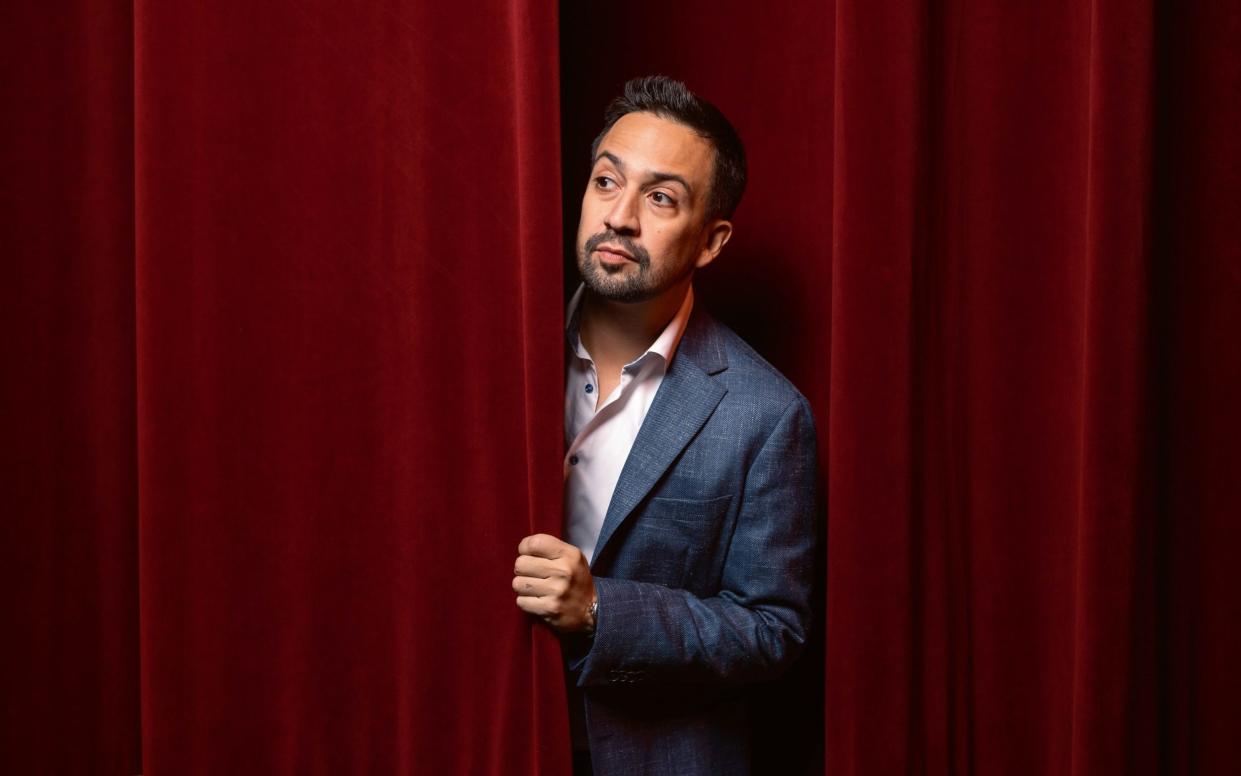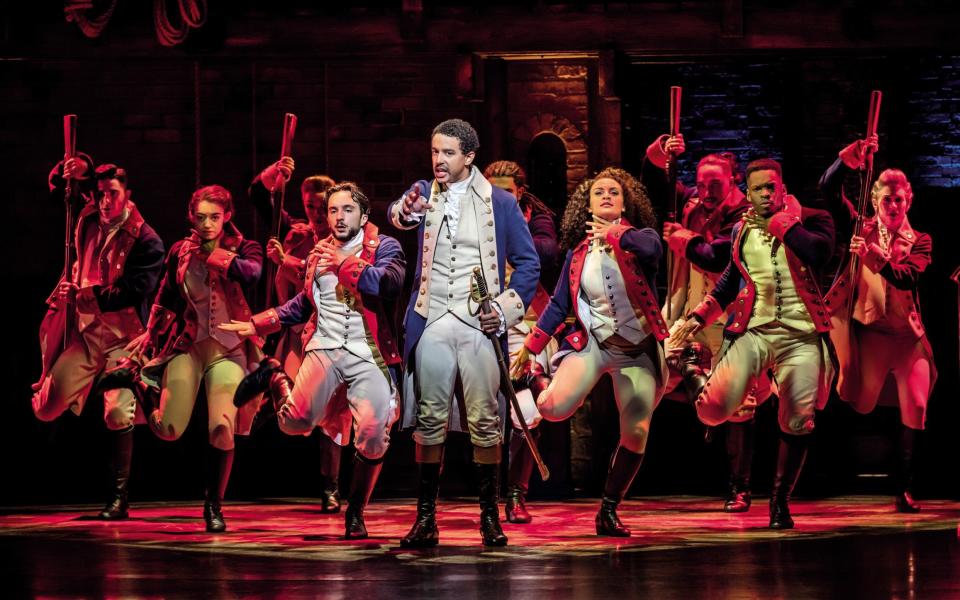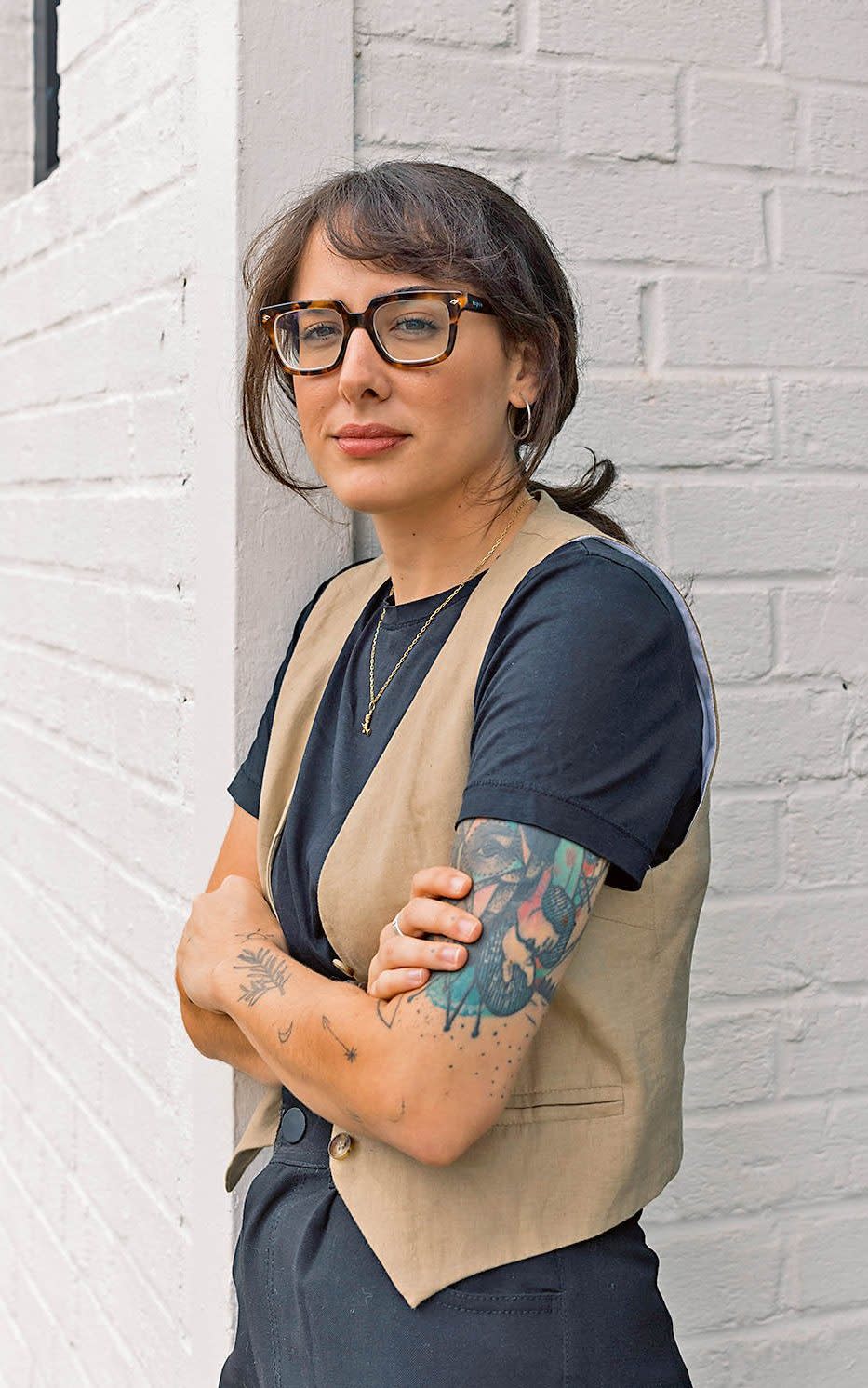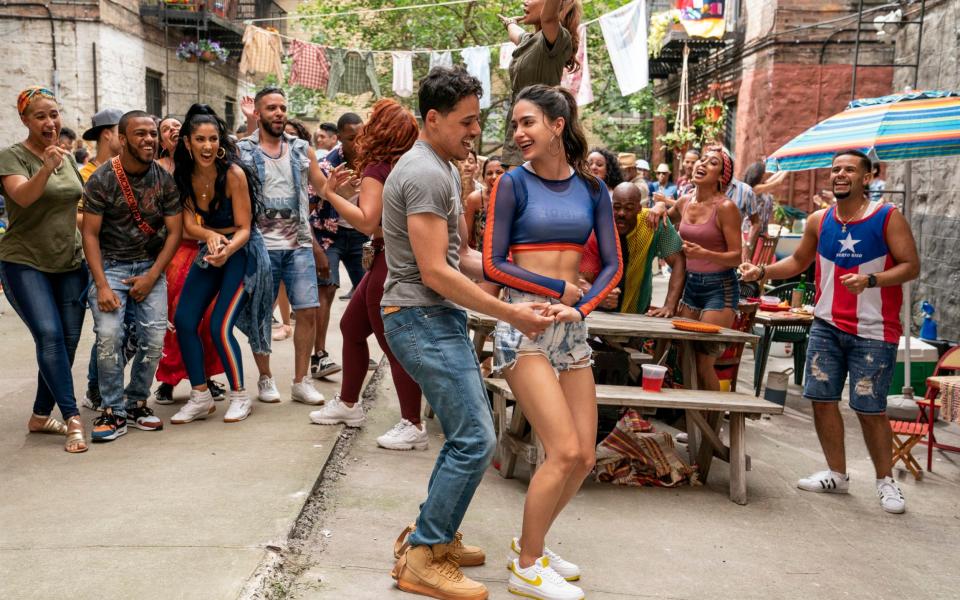Lin-Manuel Miranda: ‘Your job as an artist is to be connected to your nine-year-old self’

Not long ago, Lin-Manuel Miranda – the playwright, composer, filmmaker, actor, rapper and professional enthusiast – went to Washington DC to visit the Library of Congress, the de facto national library of America, on a simple fact-finding mission: to see just how much toil and faff is involved in creating what appears to be a product of simple genius. Specifically, the lyrics of one of his heroes, Oscar Hammerstein II.
‘I went to see his papers, and these are songs that we just learn as kids. You know, “Doh, a deer, a female deer…”,’ Miranda says, breaking lightly into song on that final phrase (he breaks lightly into song a lot) before steadying his jazz hands and holding out a palm as if to say, wait until you hear this.
‘I saw 30 pages of notes to arrive at “Doh, a deer”. Thirty. Pages. Then 15 pages to get to “So long, farewell”. You see sayonara crossed out, because that doesn’t fit. You see all the different drafts before you get to the one we know.’ The lesson? ‘That hard work can lead to beautiful, simple things.’
It’s just the kind of anecdote you might hear from an inspiring and unorthodox teacher who is keen to drill into his charges that, however far you think blazing talent can take you, you won’t get anywhere without putting the hours in, kids. And today, in an anteroom at the Brooklyn Academy of Music, New York City, that’s essentially the role Miranda is playing: not in any of his many, many more familiar capacities, but as a humble mentor.
Sitting alongside him, rapt – and possibly not hearing the story for the first time – is Agustina San Martín, a 31-year-old Argentine filmmaker and visual artist who, every few months for the past two years, has met with Miranda to collect these pearls of wisdom.
‘Oh, she mentored me a lot more than I mentored her…’ Miranda mutters, while Martín blushes a little behind her oversized tortoiseshell glasses. Theirs is a marriage of ideas, and the matchmaker was Rolex (admittedly, a significant dowry was paid), which, for the past 20 years, has quietly set about pairing young artists of ‘exceptional potential’ with often preposterously famous and successful elders for a sustained programme of ‘practical guidance and deep insight’. Essentially the couples hang out, see one another work, talk craft, and ideally form a lasting creative bond that enriches the arts.
New unions occur every two years, and the list of past mentors offering a wing to shelter under is impressive: from Martin Scorsese to Joan Jonas, David Adjaye to Colm Tóibín. The 2020-22 cycle followed suit, featuring the British theatre and film director Phyllida Lloyd, the celebrated American visual artist Carrie Mae Weems, Academy Award-winning filmmaker Spike Lee, and the man opposite me now.

‘Honestly,’ Miranda says, ‘I thought I was kind of young for this when I was first asked to do it.’ Miranda is 42 but looks younger, possibly thanks to having the energy of a pigeon trapped in a conservatory. The singing, the fidgeting, the affirmations, the boundless joy: he’s such a ray of sunshine it’s occasionally difficult to look directly at him without needing to flinch.
It’s true that Miranda is a little young to be considered a wizened veteran, but even in early middle age, his body of work and list of accolades is staggering – and that’s notwithstanding the fact that he was relatively unheard of until his late 20s, when his first musical, In the Heights (which captured life in Washington Heights, the area of Upper Manhattan in which Miranda grew up), won a Tony Award in 2008.
After that, he spent more than five years writing Hamilton, which is ostensibly also a musical, but is better described as a cultural phenomenon. Opening on Broadway at New York’s Richard Rodgers Theatre in August 2015, it used hip-hop to tell the story of the founding fathers of America, and specifically the life of the lesser-known Alexander Hamilton, who Miranda played.
Reviews weren’t so much glowing as radioactive: Miranda was compared to Shakespeare, and declared a genius (indeed, he received a Genius Grant from the MacArthur Fellows Program that year) as tickets sold out for months in advance – or commanded thousands on resale websites.
At the Tony Awards, Hamilton scored a record 16 nominations and won 11 categories. It received the Pulitzer Prize for Drama. The cast recording of the show’s songs, which ranged between rap, R&B, pop and traditional show tunes, was the highest-debuting cast recording for half a century. When a London production opened at the Victoria Palace Theatre in 2017, Hamilton fever was officially global. And almost everybody who saw it – from stale theatre hacks to A-list celebrities – had the same gushing reaction.
Barack Obama was one, while Michelle Obama called it ‘the best piece of art in any form that I have ever seen in my life’. Miranda has since directed his first film (2021’s Tick, Tick… Boom!), invaded every household with a toddler in it on the planet thanks to writing the songs for Disney’s Moana and Encanto, and thoroughly ingratiated himself this side of the Atlantic with acting roles in Mary Poppins Returns and His Dark Materials. All of which is quite enough to make him a worthwhile teacher, even if he is a little on the young side.

Most of the mentors and protégés on Rolex’s programme can be placed into a vague box: filmmaker, visual artist, architect. But Miranda and San Martín’s category was described as ‘open’, since neither of them can easily be described without a chaos of hyphens.
It’s partly why Miranda likes teaching (for a year he taught English at a high school in Manhattan): so he can spend time with unbridled, fearless young people who remind him of the joy in art. And they evidently love him back: the previous evening, at a Rolex celebration, Miranda had been sitting in the front row and assiduously listening as a local teenage choir performed. Every single one of them either sang directly to him, or pretended not to.
‘I always feel like your job as an artist is to be connected to that version of yourself: the thing that made you want to do this. To be connected to your 16-year-old self, your nine-year-old self. While we’ve been here, the teaser for The Little Mermaid [the forthcoming live-action version, for which he co-wrote songs] has dropped, and that’s the movie for me. I faked being sick the day that [the 1989 animated original] came out on VHS, because I needed to be the first to get it. I just remember feeling weightless when Under the Sea started.’
That sense of connecting with your younger self is what San Martín’s short documentary Childhood Echoes, made during her Rolex mentorship, came to be about. Previously she’d made more serious, abstract work, but this was a simple yet beautiful series of interviews with people about the music that connects them to their childhoods.
‘When I started meeting Lin and working with him, I started going back to my roots, as that young girl sitting in front of the TV watching Jurassic Park for the 20th time, with my parents telling me I need to eat,’ she says. ‘It reminded me of that broader audience. Now I understand the biggest power is in the emotional.’

When they met, San Martín had already directed films (her Monster God won a Short Films Special Mention at Cannes in 2019), but Miranda’s directorial debut, Tick, Tick… Boom!, produced during the pandemic, was all to come. Before he made it, he was worried he’d be a terrible, overly frenetic filmmaker. It’s what he means by the mentoring going two ways.
‘At our first meeting we talked a lot about how I might be so in love with the fact I’m actually getting to live my dream, and make a movie, that I’m not actually seeing what I’m making,’ he says. ‘So I learnt from her how to see what’s in front of me. How do I… calm down?’ San Martín, effortlessly chilled and sitting Buddha-like cross-legged in a chair beside him, just smiles. It’s a tall order.
The son of Puerto Rican parents (Lin-Manuel and his father, Luis, a political consultant, last month co-authored an op-ed in The Washington Post about the best ways to get aid to Puerto Rico after the devastation of Hurricane Fiona), Miranda still lives in roughly the same neighbourhood he always has. He married his high-school crush, lawyer Vanessa Nadal, in 2010 and performed To Life from Fiddler on the Roof at the wedding. They have two sons, four-year-old Francisco and seven-year-old Sebastian, who’s named after the small Jamaican crab from The Little Mermaid.

Unending enthusiasm and overwhelming niceness are his dominant character traits, but they always have been. Miranda has little time for ‘cool’, he says, and has always liked that about Broadway: that while people may be prone to luvviness, they’re also supportive and talk to one another.
He obviously never met Hammerstein, who, with composer Richard Rodgers, created Oklahoma!, Carousel, The King and I and The Sound of Music, but as a young man Miranda did meet Hammerstein’s protégé, the late Stephen Sondheim, plus Andrew Lloyd Webber, and John Kander, who co-wrote Cabaret and Chicago.
‘The great thing about musical theatre is that you can meet your heroes. It’s the same 15 blocks. I met John [Kander] in 2007, and that’s been one of the most remarkable mentoring experiences of my life. Because there are people you meet who destroy the myth of the tortured genius, and that is a myth that should be destroyed if you want to have a nice, long, healthy and productive life.’
Kander and Sondheim taught him that being polite and hard-working is not antithetical to great art. ‘[John’s] got a house upstate, an apartment on the Upper West Side; he’s the nicest man I’ve ever met. And Sondheim told me to reach out and send him what I was working on, and he always wrote back.’
Miranda is an itinerant writer, drawing from the Latino community surrounding him for In the Heights, and composing Hamilton by walking endlessly around Manhattan, freestyling to himself about legislation reform and drawing rhythm from the city, which resulted in a show as remarkable for its sheer energy as for its music. Now its creator is an A-list star who’s an Oscar short of an EGOT (that elite club of stars who’ve won an Emmy, a Grammy, an Oscar and a Tony). I imagine it’s not very easy to prowl around anonymously these days.
‘I can in my neighbourhood. I can’t do it on, like, 46th street, but in my neighbourhood I’m the village idiot. I’m like a character. I have my dog, my headphones on, and people leave me alone,’ he says. ‘That’s one of the places where Covid helped. I’ve done some of my best writing on the subway, and there was a moment in 2016, 2017 where I missed that. But I can wear a mask and kind of go anywhere now… I’m just the masked composer on the subway.’

After In the Heights, he says, everybody expected him to do another musical about the contemporary Latino experience. So he did Hamilton, which was, in many ways, the opposite. After that, he was offered blank cheques to do another historical hip-hopera. So he did a BBC fantasy adaptation of His Dark Materials, and a clutch of Disney films, including Mary Poppins Returns, where he was a cockney chimney sweep with an accent learnt from Dick Van Dyke rather than any actual Londoner.
You may have spotted the pattern. What he took from the Rolex mentoring programme, and tried to impress upon San Martín, was the value of having time to work. And now, just as we’re growing familiar with his face on-screen, he says he’s done appearing in front of the camera completely.
‘I’ve really kind of taken a break from being in things. Sometimes I get offered a role and I think, “I can picture who can do it better than me, and I don’t need to do this.” That happens a lot, I talk myself out of a lot of gigs,’ he says, slowly for once.
‘And honestly, I think Sondheim’s passing last year lit a fire under me. There are stories within us that we carry around like luggage. And if you don’t get the time to write them, they’re not going to get written. So I’m back to the grindstone. I get great joy out of acting, but I’m needed at my piano.’
So long and farewell, then. Simple genius takes hard work. And Lin-Manuel Miranda has a fire under him.

 Yahoo News
Yahoo News 
